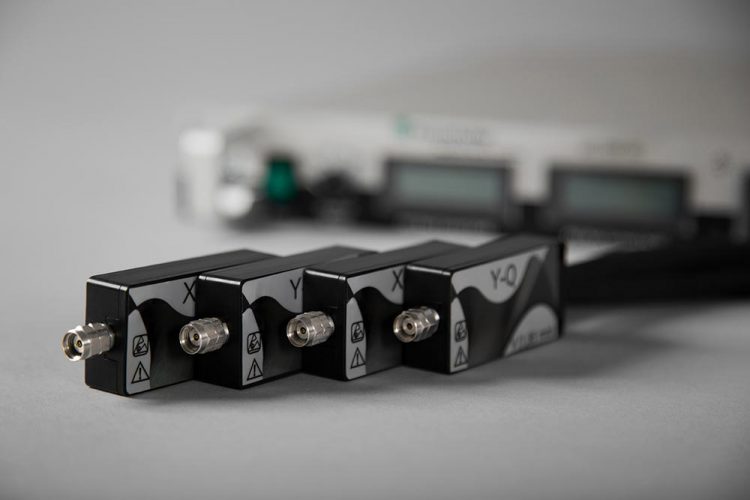Fraunhofer HHI have developed a novel single-polarization Kramers-Kronig receiver scheme

Fraunhofer Heinrich Hertz Institute HHI developed a distributed superchannel aggregation scheme to demonstrate ultra-wideband single-photodiode reception based on inherently polarization-aligned Kramers-Kronig (KK) carrier generation at the receiver. For optimized conditions, a record net capacity of 400 Gb/s was achieved using a distributedly aggregated superchannel of 3×33 GBd 32QAM sub-carriers.
The need to establish and implement high capacity, simplified and cost-effective direct-detection (DD) schemes for short reach systems, such as data center interconnect (DCI), is propelling optical communication industries to find innovative techniques to realize these goals.
Contrary to other DD schemes, the single-polarization Kramers-Kronig technique allows the reception of complex modulation formats with a single photodiode by additionally using a Kramers-Kronig carrier, which needs to be polarization-aligned to the data signal. To avoid receiver-based polarization control, the KK carrier is usually co-generated at the transmitter.
In contrast to this already existing scheme, researchers at Fraunhofer HHI have developed a novel single-polarization Kramers-Kronig receiver scheme, which is based on the generation of an inherently polarization-aligned Kramers-Kronig carrier in the receiver.
The combination of a distributed superchannel aggregation based on optical bus topology and the receiver-based KK carrier generation, enables KK reception of ultra-wideband signals without using ultra-wideband transmitters.
The researchers distributedly aggregate a 3×33 GBd superchannel spanning more than 100 GHz with a 495 Gb/s gross rate using the bus topology concept. In the scheme, a master continuous wave (CW) is propagated through the bus and collects locally generated sub-carriers (SCs) of each optical node along the bus. In the receiver, a similar node is used to generate the KK carrier.
As the polarizations of the superchannel and the generated KK carrier are determined by the state-of-polarization (SOP) of the incoming master CW, automatic polarization alignment of the KK carrier and the data is achieved without the need for polarization tracking.
Each SC in the superchannel was detected with error-free performance and a 400 Gb/s payload was achieved. This is the highest capacity reported so far for single-polarization single-photodiode KK reception.
By applying this technology to short reach and metro-haul optical networks (e.g., data center interconnect), the cost and complexity of the communications environment could be reduced.
Details of this technology were presented during OFC 2018.
https://www.hhi.fraunhofer.de/en/press-media/press-releases.html
Media Contact
All latest news from the category: Physics and Astronomy
This area deals with the fundamental laws and building blocks of nature and how they interact, the properties and the behavior of matter, and research into space and time and their structures.
innovations-report provides in-depth reports and articles on subjects such as astrophysics, laser technologies, nuclear, quantum, particle and solid-state physics, nanotechnologies, planetary research and findings (Mars, Venus) and developments related to the Hubble Telescope.
Newest articles

A universal framework for spatial biology
SpatialData is a freely accessible tool to unify and integrate data from different omics technologies accounting for spatial information, which can provide holistic insights into health and disease. Biological processes…

How complex biological processes arise
A $20 million grant from the U.S. National Science Foundation (NSF) will support the establishment and operation of the National Synthesis Center for Emergence in the Molecular and Cellular Sciences (NCEMS) at…

Airborne single-photon lidar system achieves high-resolution 3D imaging
Compact, low-power system opens doors for photon-efficient drone and satellite-based environmental monitoring and mapping. Researchers have developed a compact and lightweight single-photon airborne lidar system that can acquire high-resolution 3D…





















